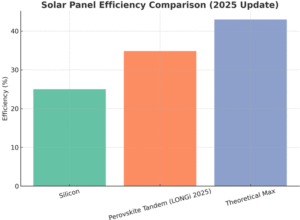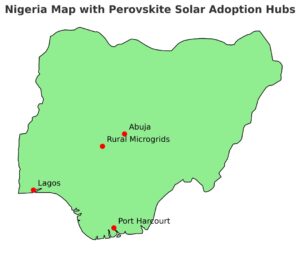Perovskite solar cells are rewriting the rules of renewable energy. In April 2025, LONGi set a new world record with a 34.85% efficiency in its double-terminal silicon–perovskite tandem cell, certified by NREL. This represents a dramatic leap beyond conventional silicon modules and signals the dawn of a new era in clean power. For Nigeria—where affordable and reliable electricity remains a national priority—this breakthrough technology offers a pathway to transform its energy future.
What Makes Perovskite Solar Cells Different?
Traditional monocrystalline silicon panels typically achieve efficiencies of 20–23%, with the most advanced commercial models (such as Maxeon and Trina HJT) reaching around 24–25%. In laboratory conditions, silicon cells have achieved up to 26.7% efficiency. By contrast, tandem designs combining silicon with perovskite layers are now reaching 34.85%—a record set by LONGi in April 2025—closing in on the theoretical maximum of about 43%. This means far more power can be harvested from the same surface area.

Why Nigeria Should Pay Attention
Nigeria faces a pressing energy challenge, with millions relying on costly and polluting diesel generators. Perovskite technology offers a game-changing alternative because of its high efficiency, potential for lower manufacturing costs, and versatile applications—from lightweight rooftop panels to microgrids for rural communities.
Nigeria’s natural resources, such as tin and silica, combined with growing academic and industrial interest, position the country to play a role in perovskite development. Adoption could not only improve domestic energy security but also establish Nigeria as a clean-energy manufacturing hub in Africa.

Local Academic Interest
In April 2025, Dr. Adeyinka David Adewoyin of the University of Lagos presented at a Distance Learning Institute seminar on numerical modeling of lead-free perovskite solar cells. While results are still preliminary and no peer-reviewed publications are available, this highlights growing Nigerian academic interest in next-generation renewable technologies. Such initiatives could seed local innovation and partnerships in the coming years.
Figure 3: Spotlight on University of Lagos academic interest in lead-free perovskite research.
What Needs to Happen Next?
– **Improve Stability**: Ongoing R&D must focus on enhancing durability against heat, humidity, and material degradation.
– **Invest in Local Manufacturing**: Partnerships between universities, government agencies, and renewable energy companies are essential to build pilot production lines.
– **Supportive Policy Frameworks**: Tax incentives, research grants, and national renewable standards will be vital for accelerating adoption and scaling up production.
Why GreenRise Power Should Lead the Charge
At GreenRise Power, we believe innovation is the key to solving Nigeria’s energy challenges. By exploring and preparing for the adoption of perovskite solar technologies, we aim to deliver higher-efficiency, cost-effective solutions that can transform both urban and rural energy landscapes.
⚡ Want to see how next-gen solar could benefit your home or business?
👉 Request a Free Solar Assessment
Conclusion
The arrival of tandem perovskite solar cells represents more than a technological milestone. For Nigeria, it offers a chance to redefine its energy trajectory—away from dependence on diesel and toward clean, affordable, and sustainable electricity. With innovation, collaboration, and leadership from companies like GreenRise Power, Nigeria can seize this moment and help shape the future of renewable energy in Africa.
🌍 Ready to power your future with GreenRise?
References
- LONGi. (2025). ‘LONGi sets new world record of 34.85% efficiency for silicon–perovskite tandem solar cell (NREL certified)’. https://www.longi.com
- Solar Reviews. (2025). ‘Most efficient solar panels in 2025 – Maxeon and Trina benchmarks’. https://www.solarreviews.com
- Clean Energy Reviews. (2025). ‘Highest efficiency solar panels: 2025 guide’. https://www.cleanenergyreviews.info
- Wikipedia. ‘Monocrystalline silicon’. Laboratory record efficiencies. https://en.wikipedia.org/wiki/Monocrystalline_silicon
- University of Lagos. (2025). ‘Dr. Adewoyin illuminates Nigeria’s energy future with perovskite solar cells at DLI seminar’. https://unilag.edu.ng
